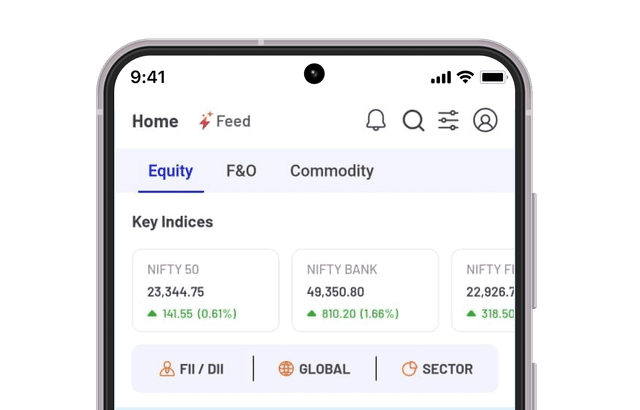Monthly Breakout Stocks
Last updated on: December 24, 2025
A monthly breakout stock is a stock that moves significantly beyond a defined level, often with increased trading volume, indicating potential opportunities for long or short positions. Traders analyse historical price data and chart patterns to identify potential breakout candidates, often using technical indicators like moving averages, trendlines, and volume analysis to confirm the strength and validity of the breakout signal. Breakout stocks on monthly charts show potential for significant price movement.
5,216.45 | 110427.57 | 409.04 | 3285.33 | |
724.40 | 25454.52 | 244.02 | 2294.01 | |
925.40 | 16937.17 | 276.49 | 3467.02 | |
31.20 | 238.02 | -0.56 | 44.45 | |
3.51 | 55.56 | 164.22 | 234.39 | |
131.35 | 2719.03 | 1.92 | 362.63 | |
319 | 644.68 | -16.89 | 69.34 | |
6,033 | 17795.92 | 182.37 | 1551.85 | |
485 | 5596.92 | 9.86 | 1102.7 | |
18.57 | 2372.06 | -105.25 | 1157.19 | |
18,346 | 24182.79 | 350.7 | 2081.4 | |
1,014.85 | 631488.57 | 4947.76 | 19867.45 | |
439.05 | 8898.95 | 53.89 | 1670.76 | |
698.50 | 9993.3 | 138.9 | 1031.36 | |
1,695.05 | 18951.96 | -17.82 | 96.77 | |
3,911.50 | 16908.45 | 107.15 | 4042.41 | |
953.45 | 12180.55 | 13.9 | 801.33 | |
1,860.15 | 15555.47 | 48.03 | 839.09 | |
400.05 | 292427.7 | 1278.42 | 5792.09 | |
89.92 | 2249.68 | 40.45 | 325.1 | |
7.62 | 23.9 | -0.81 | - | |
136.15 | 408.15 | 0.71 | 176.07 | |
1,770 | 36548.03 | 98.78 | 2422.37 | |
12,050 | 1753.06 | 12.2 | 103.7 | |
62.40 | 305.41 | -0.19 | 19.84 | |
299.80 | 1008.93 | 0.74 | 271.33 | |
168.40 | 22322.61 | 445 | 5267 | |
473.35 | 18964.88 | 648.75 | 6412.76 | |
367 | 31195 | 173.64 | 4364.51 | |
1,495.65 | 120870.85 | 1353.07 | 7447.42 |
5,216.45 | |
724.40 | |
925.40 | |
31.20 | |
3.51 | |
131.35 | |
319 | |
6,033 | |
485 | |
18.57 | |
18,346 | |
1,014.85 | |
439.05 | |
698.50 | |
1,695.05 | |
3,911.50 | |
953.45 | |
1,860.15 | |
400.05 | |
89.92 | |
7.62 | |
136.15 | |
1,770 | |
12,050 | |
62.40 | |
299.80 | |
168.40 | |
473.35 | |
367 | |
1,495.65 |
About Monthly Breakout Stocks
Stocks that exhibit notable monthly price swings, frequently breaching important resistance levels or trading ranges, are referred to as monthly breakout stocks. These stocks are closely monitored by traders and investors as they may present opportunities for short-term trading or signal underlying strength in a company's fundamentals or market sentiment. Traders look for clear breakout signals, such as a significant price increase and high trading volume, to confirm the pattern and potentially enter positions. Successful trading of these stocks requires a combination of technical analysis, market understanding, and risk management. Traders need to be alert and flexible in response to shifting market conditions.
Why are Monthly Breakout Stocks Important?
- Monthly breakout stocks are crucial for traders as they offer opportunities to make money and understand stock market trends.
- These stocks indicate significant price changes, often signalling changes in a company or the market. By paying attention to breakout stocks, traders can learn about market trends and identify potential profit opportunities.
- They also indicate a company's performance, suggesting better-than-expected performance or investor excitement about its future.
- Traders and investors pay attention to breakout stocks to know how to find investment opportunities in companies doing well.
- They also help traders understand market changes, allowing them to adjust their strategies accordingly, making better decisions and avoiding losing money in the stock market.
Features of Monthly Breakout Stocks
Monthly breakout stocks are equities that experience major price fluctuations or breakouts every month. Investors and traders are drawn to these stocks because they have the potential for significant profits or losses. Here are some major characteristics of monthly breakout stocks listed below:
- Price Volatility: Monthly breakout stocks often have higher price volatility than steady or low-volatility equities. This volatility can be caused by a variety of events, including earnings releases, business developments, changes in market sentiment, and sector-wide trends.
- Technical Breakouts: Technical analysis is critical in finding monthly breakout stocks. Traders and investors often search for equities that break resistance or support levels on the price chart, which indicate probable trend reversals or continuation patterns.
- Fundamental Catalysts: While technical analysis primarily drives breakout trading strategies, fundamental factors can also contribute to monthly breakouts. Positive earnings releases, new product launches, strategic partnerships, regulatory approvals, or favourable macroeconomic conditions can act as catalysts for stock price appreciation.
- Sector Rotation: Sector rotation can influence monthly breakout stocks as investors reallocate capital based on changing market dynamics and economic trends. Certain sectors may experience periods of outperformance or underperformance, leading to breakouts in stocks within those sectors as capital flows in or out.
- Risk Management: Trading monthly breakout stocks requires effective risk management strategies. Volatility can result in rapid price fluctuations, increasing the risk of losses if trades are not properly managed. Traders often use stop-loss orders, position sizing techniques, and risk-reward ratios to mitigate risk and protect capital. Keeping an eye on monthly breakout stocks with high volume can offer valuable insights into potential market movers and robust returns.
- Technical Indicators: Traders may utilise technical indicators such as moving averages, relative strength index (RSI), momentum oscillators, and Bollinger Bands to identify potential breakout candidates and confirm the strength of breakout signals. Identifying breakout stocks today is crucial for investors seeking opportunities in the current market landscape.
